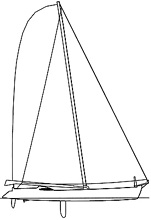PlayStation
Multihull Speedsterr
Let's take a look at some interesting PlayStation numbers. The big cat is 105 feet long and 60 feet wide. The mast tip is 147 feet above the water. (Hey! I can't see the Windex.) The designers won't divulge the displacement of this cat, but this did not stop me from pulling out my trusty tick strip and doing some scaling and estimating. I estimated a prismatic coefficient between .64 and .68 so I used .66 and applied it to an amidships immersed area of 8.84 square feet and came up with a displacement of 38,460 pounds. I really don't think I'm far off.
Using this estimated displacement the D/L of this design is 15.71. No, that's not the SA/D. The SA/D is 102 for upwind and 163 for downwind. These numbers are so far off the scale that they defy comparison. Estimating the beam of each hull at 5 feet, 6 inches, I come up with an L/B of 18.39. With that number in mind you have to throw out your "hull speed" speed-to-length ratio of 1.34 times the square root of the waterline. Using that formula we would come up with a top speed of 13.6 knots. But with extremely narrow hulls the speed-length ratio increases. We know that Morelli & Melvin count on PlayStation doing 35 knots. That's a speed-length ratio of 3.5. I thinkÑproviding they can keep the big cat togetherÑthat speeds in excess of 40 knots are possible.
I called on my own client Paul Scott, a dedicated tech head, to do some research for me on the speeds of long skinny hulls. After a thorough search of the Internet, Paul came up with a hull speed formula by Richard Boehmer. Using a theoretical sail area of 10,000 square feet, Boehmer's formula gives us a hull speed of 47.56 knots. Using another formula from Steve Edmonds, the hull speed calculates to 44.49 knots based upon an estimated BWL of 5 feet.
Structural design of this vessel was done by High Modulus of New Zealand and construction was by Mick Cookson of Auckland. There are no textbooks for engineering a structure like this. All the engineering work is cutting edge. The result is a fairly "normal" layup of unidirectional pre-preg carbon fiber skins over both Nomex and aluminum honeycomb cores.
The rig uses carbon fiber foils for the furling headsails. The 5,300-square-foot mainsail weighs 1,760 pounds. I couldn't figure out what that wedge was that hangs down from the outboard end of the boom, so I called Gino Morelli. Apparently it allows a sliding upper mainsheet block to maintain perpendicularity with the noncurved mainsheet traveler track. Battens are all carbon fiber. The gooseneck is located on the main crossbeam, keeping the boom loads off the mast. There are no turnbuckles for the rigging. The rigging tension is adjusted with Spectra lashings. This saves weight.
I'm sure PlayStation will be splashed all over all the sailing mags in the next few months. I wish Fossett and crew the best of luck. There are two more, even bigger cats already under construction in Europe.

Comments